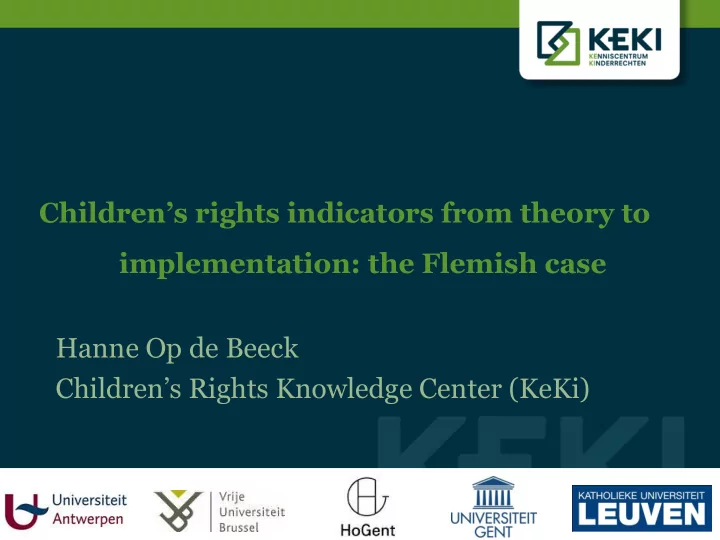

Children’s rights indicators from theory to implementation: the Flemish case Hanne Op de Beeck Children’s Rights Knowledge Center (KeKi)
Overview I. Introduction: • Belgium and Flanders • Flemish Action Plan for Children’s Rights • ‘Indicators’ as KeKi’s 2012 theme II. KeKi’s study III. KeKi’s recommendations IV. The Flemish Government’s approach Children’s rights indicators from theory to implementation: the Flemish case
Introduction Children’s rights indicators from theory to implementation: the Flemish case 3
Belgian Communities – Inhabitants of a Language Area Flemish Community • (+/- 6.000.000 people) French Community • (+/- 4.000.000 people) German-speaking Community • (+/- 75.000 people) Children’s rights indicators from theory to implementation: the Flemish case 4
Flemish Action Plan on children’s rights • 2011 – 2014 • 1 of the priorities: Coordination and indicators • “The coordinating administration (youth) works, in cooperation with the research support service of the Flemish Government, on a basic set of core indicators regarding children’s rights at the Flemish level (a ‘ Flemish children’s rights monitor’) by the end of 2013 […]” (Flemish Government, 2011: 20, own translation) KeKi 2012 theme: children’s rights indicators • ! KeKi does not develop indicators Children’s rights indicators from theory to implementation: the Flemish case 5
KeKi’s study Children’s rights indicators from theory to implementation: the Flemish case 6
What are children’s rights indicators? • Definition? - children’s rights indicators vs. monitoring indicators - structure, process and outcome indicators - indicators versus data => concept-driven vs. data-driven approach => interpretation of data: not a task for researchers (?) “ a children’s rights indicator is a specific indication, based on particular data, of the extent to which a well defined right of children is being realised, starting from an explicitly demarcated normative framework ” Children’s rights indicators from theory to implementation: the Flemish case
Critical reflections • Fundamental critiques: - Technologization of social debate => concern of civil society and policy => indicators as food for social debate => Attention for multidimensionality of children’s rights - Role of the expert - Tokenism =>concern of civil society and policy => what is the cost? Children’s rights indicators from theory to implementation: the Flemish case
Critical reflections Methodological challenges: • - Limitations of numbers =>official and self-report data => centralize official data and broaden self-report data - Underrepresentation of qualitative research (E.g. Nairn, Duffy, Sweet & Swieckica, 2011 / Ipsos Mori institute) - Participation => ownership of children and youth => involvement of civil society - Interregional comparability Children’s rights indicators from theory to implementation: the Flemish case
KeKi’s recommendations Children’s rights indicators from theory to implementation: the Flemish case 10
KeKi’s recommendations • General 1. Distinguish between indicators and data 2. First develop the indicators, then gather the data 3. Strengthen awareness about the limitations of indicators • Development of indicators 4. Distinguish between ‘children’s rights indicators’ and ‘monitoring indicators’ 5. Distinguish between ‘ structure ’, ‘ process ’ and ‘ outcome ’ indicators 6. Pay attention to positive evolutions 7. Create a participatory process 8. Create long term stability in the indicators 9. Pursue interregional comparability Children’s rights indicators from theory to implementation: the Flemish case 11
KeKi’s recommendations • Filling in indicators (data) 10. Use – as much as possible – existing data 11. New research: involve children and youth from socially vulnerable groups 12. New research: also invest in qualitative, interpretative research 13. New research: also invest in projects that use a child-friendly methodology Children’s rights indicators from theory to implementation: the Flemish case 12
The Flemish Government’s approach Children’s rights indicators from theory to implementation: the Flemish case 13
The Flemish Government’s approach: description • Project team (3 government members) develops methodology with a specific input from feedback group • Feedback group consists of interested stakeholders from the children’s rights field (practice/civil society) • So far, the following steps have been taken 1. First meeting of feedback group: open brainstorm. Which indicators should be included in the children’s rights monitor? 2. Second meeting of feedback group: discussion. Which indicators should be kept? 3. Third meeting of feedback group: discussion of selection Children’s rights indicators from theory to implementation: the Flemish case 14
The Flemish Government approach: evaluation • Strong participation of civil society: – shows great concern for input from practice/civil society – is in line with recommendation nr. 7: ‘ Create a participatory process ’ – voice of children & youth not directly involved • Inspiration in Dutch children’s rights monitor and adjustment towards concluding observations allows this instrument to be shaped within an international framework Children’s rights indicators from theory to implementation: the Flemish case 15
The Flemish Government approach: evaluation • ‘ Bottom-up ’ approach: Strong participation from stakeholders – – Lack of clear normative framework : ‘ wish list’ of participants? – Non-representative: over-representation of professional domains of participants? • No clear distinction between data and indicators (≠ recommendation 1) • Data-driven approach No clarity about goal of monitor: • – Broad view on children’s rights in Flanders? or – Focus on ‘ filling gaps ’ in existing data? • Methodology so far resulted in fragmented compilation of indicators Children’s rights indicators from theory to implementation: the Flemish case 16
Conclusion Children’s rights indicators from theory to implementation: the Flemish case 17
Conclusion Positive intentions: - efforts to follow up children’s rights • implementation - much attention for concerns and advice from civil society A more structured approach would have entailed a more • comprehensive set of indicators Developing indicators is difficult, but the indicator developing process can be valuable as well: it can start a dynamic towards a more evidence-based policy Children’s rights indicators from theory to implementation: the Flemish case 18
Thank you Questions? Hanne Op de Beeck Children’s Rights Knowledge Centre Hanne.opdebeeck@keki.be Children’s rights indicators from theory to implementation: the Flemish case 19
Recommend
More recommend